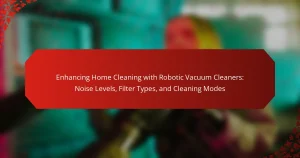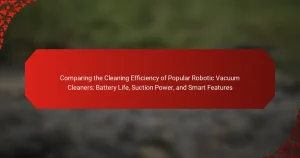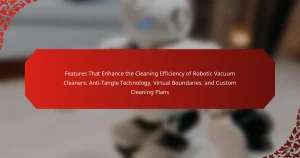Robotic vacuum cleaners are automated devices designed for floor cleaning without human intervention, utilizing sensors for navigation and obstacle detection. This article explores the cleaning efficiency of robotic vacuum cleaners through key features such as suction power, dirt detection capabilities, and cleaning coverage area. It also examines the importance of maintenance practices, including regular cleaning of brushes and filters, to enhance performance. Additionally, the article highlights the correlation between advanced navigation systems and improved cleaning outcomes, providing a comprehensive understanding of how these devices operate and maintain efficiency.

What are Robotic Vacuum Cleaners and How Do They Work?
Robotic vacuum cleaners are automated devices designed to clean floors without human intervention. They operate using sensors to navigate and detect obstacles. Most models have rotating brushes and suction mechanisms to pick up dirt and debris. They can be programmed to follow specific cleaning schedules. Many robotic vacuums feature mapping technology for efficient coverage of spaces. Some models can connect to Wi-Fi for remote control via smartphone apps. The battery life typically ranges from 60 to 120 minutes, depending on the model. After cleaning, these devices return to their charging docks automatically.
What are the key components of robotic vacuum cleaners?
The key components of robotic vacuum cleaners include the navigation system, suction mechanism, brushes, dustbin, battery, and sensors. The navigation system allows the robot to map and traverse its environment efficiently. The suction mechanism is responsible for removing dirt and debris from surfaces. Brushes, often a combination of side and main brushes, help to agitate and sweep debris into the suction path. The dustbin collects the debris, and its capacity varies by model. The battery powers the vacuum, with most models featuring lithium-ion batteries for longer life. Sensors, such as cliff sensors and obstacle detection, help the robot avoid falls and navigate around furniture. These components work together to enhance cleaning efficiency and user convenience.
How do sensors in robotic vacuum cleaners enhance cleaning efficiency?
Sensors in robotic vacuum cleaners enhance cleaning efficiency by enabling precise navigation and obstacle detection. These sensors include infrared, ultrasonic, and cliff sensors. Infrared sensors help the vacuum detect obstacles in its path. Ultrasonic sensors can identify the distance to objects, allowing for smoother navigation. Cliff sensors prevent the vacuum from falling off edges, such as stairs.
By using these sensors, robotic vacuums can create efficient cleaning paths. They adapt their cleaning strategies based on the environment. For example, they may increase suction power in areas with more dirt. Studies show that robotic vacuums with advanced sensors can clean up to 30% more effectively than those without. This increased efficiency leads to improved overall cleanliness in homes.
What role does navigation technology play in their operation?
Navigation technology is essential for robotic vacuum cleaners’ operation. It enables these devices to map their environment accurately. Advanced navigation systems use sensors and cameras for obstacle detection. They help the vacuum avoid furniture and other barriers. This technology allows for efficient cleaning patterns. It reduces the chances of missing spots. Some models use artificial intelligence to improve navigation over time. Studies show that better navigation leads to higher cleaning efficiency.
What are the main features of robotic vacuum cleaners?
Robotic vacuum cleaners have several main features. They are equipped with smart navigation systems that allow them to map and navigate spaces efficiently. Many models include sensors to detect obstacles and avoid collisions. They often feature programmable schedules for automated cleaning at specific times. Some robotic vacuums have the ability to return to their charging stations when the battery is low. They may also include HEPA filters to capture allergens and improve air quality. Additionally, many models offer connectivity options for remote control via smartphone apps. These features enhance their usability and effectiveness in maintaining clean floors.
How does suction power affect cleaning performance?
Suction power directly influences cleaning performance in robotic vacuum cleaners. Higher suction power enhances the ability to pick up dirt, debris, and pet hair from various surfaces. It allows the vacuum to effectively remove particles embedded in carpets and rugs. Studies show that vacuums with greater suction can clean deeper and more thoroughly. For instance, a vacuum with 2000 Pa suction power can outperform one with 1000 Pa in cleaning tests. This increased suction also helps in tackling larger debris and stubborn stains. Therefore, suction power is a critical metric for evaluating cleaning efficiency in robotic vacuum cleaners.
What types of brushes are available and how do they impact cleaning?
There are several types of brushes available for robotic vacuum cleaners, each impacting cleaning efficiency differently. The primary types include bristle brushes, rubber brushes, and combo brushes. Bristle brushes are effective for picking up dirt and debris from carpets due to their ability to agitate fibers. Rubber brushes are designed to minimize hair tangles and are more effective on hard floors. Combo brushes combine both bristles and rubber, offering versatility for different surfaces.
The choice of brush type directly affects cleaning performance. Bristle brushes may excel on carpets but can scatter debris on hard floors. Rubber brushes provide consistent cleaning on hard surfaces and are less prone to clogging. Combo brushes can adapt to various floor types, enhancing overall cleaning efficiency. The design and material of the brushes also influence their durability and maintenance needs. Regularly replacing worn brushes is essential for optimal cleaning performance.
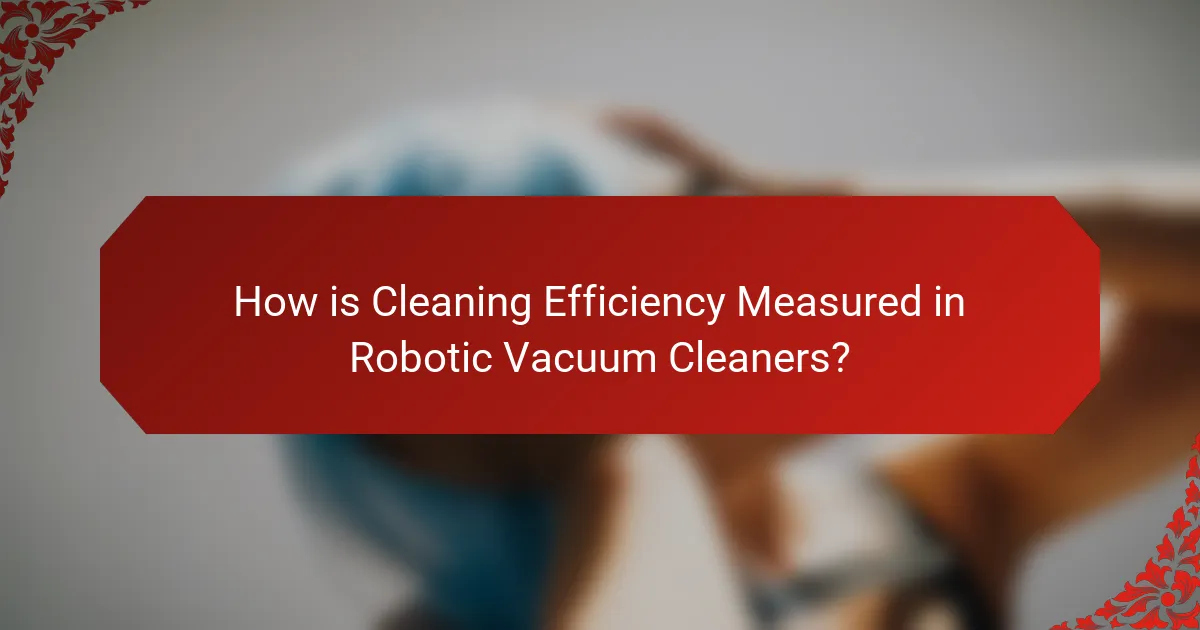
How is Cleaning Efficiency Measured in Robotic Vacuum Cleaners?
Cleaning efficiency in robotic vacuum cleaners is measured by several key metrics. These include the cleaning coverage area, dirt detection capabilities, and suction power. The cleaning coverage area refers to the total surface area the vacuum can clean in a single cycle. Dirt detection capabilities assess how effectively the vacuum identifies and targets dirtier areas. Suction power is quantified in pascals (Pa) and indicates the strength of the vacuum’s suction.
Additionally, cleaning efficiency can be evaluated through the time taken to clean a specific area. This is often measured in minutes and provides insight into the vacuum’s speed and effectiveness. The ability to maintain consistent cleaning performance over various floor types also contributes to overall efficiency.
Real-world tests often involve measuring the amount of debris collected after a cleaning cycle. This provides a tangible indicator of performance. Studies have shown that higher suction power and better navigation systems correlate with improved cleaning outcomes. Thus, these metrics collectively determine the cleaning efficiency of robotic vacuum cleaners.
What performance metrics are commonly used to evaluate cleaning efficiency?
Common performance metrics used to evaluate cleaning efficiency include cleaning coverage, dirt detection, suction power, and run time. Cleaning coverage measures the area cleaned within a specific time frame. Dirt detection assesses the ability to identify and target dirtier areas. Suction power indicates the strength of the vacuum’s ability to lift debris. Run time reflects how long the vacuum can operate before needing a recharge. These metrics provide a comprehensive overview of a robotic vacuum cleaner’s effectiveness in maintaining cleanliness.
How does battery life influence overall performance?
Battery life significantly influences the overall performance of robotic vacuum cleaners. A longer battery life allows the vacuum to operate for extended periods without needing to recharge. This means it can cover larger areas and complete more cleaning tasks in a single cycle. When the battery is low, the vacuum may return to its charging dock prematurely, resulting in incomplete cleaning. Additionally, a powerful battery can maintain suction strength throughout its operation. In contrast, a weak battery may lead to reduced performance, as the vacuum struggles to maintain optimal power. Studies show that robotic vacuums with higher capacity batteries can clean up to 30% more area on a single charge. Therefore, battery life is a crucial factor in determining the efficiency and effectiveness of robotic vacuum cleaners.
What is the significance of dustbin capacity in cleaning efficiency?
Dustbin capacity significantly impacts cleaning efficiency in robotic vacuum cleaners. A larger dustbin allows for extended cleaning sessions without the need for frequent emptying. This means the device can cover more area in one go, enhancing overall productivity. Additionally, larger capacities can accommodate more debris, which is crucial for maintaining suction power. When the dustbin fills up, the vacuum’s performance may decline, leading to reduced cleaning effectiveness. Research indicates that robotic vacuums with larger dustbins can clean up to 30% more area before maintenance is required. This efficiency is vital for users with larger spaces or pets, where debris accumulation is higher.
What factors affect the cleaning efficiency of robotic vacuum cleaners?
The cleaning efficiency of robotic vacuum cleaners is affected by several factors. These include the design of the vacuum, such as suction power and brush type. The layout of the space being cleaned also plays a significant role. Obstacles and furniture arrangement can hinder movement and cleaning paths. The type of flooring impacts performance, with carpets generally requiring more power than hard surfaces. Additionally, the vacuum’s navigation technology influences how effectively it maps and cleans an area. Regular maintenance, such as emptying dustbins and cleaning filters, is crucial for optimal performance. Finally, the battery life determines how long a robotic vacuum can operate before needing a recharge.
How do floor types impact the effectiveness of robotic vacuum cleaners?
Floor types significantly impact the effectiveness of robotic vacuum cleaners. Different surfaces affect how well these devices can pick up debris. For instance, hardwood floors allow for smoother navigation and better suction. Carpets can hinder movement and reduce suction efficiency. Low-pile carpets are generally easier for robotic vacuums compared to high-pile ones. Additionally, tiles and linoleum are often easier to clean than textured surfaces. According to a study by the University of Illinois, robotic vacuums perform best on hard surfaces, achieving up to 90% debris removal. Therefore, the type of flooring directly influences cleaning performance and efficiency.
What is the effect of pet hair and debris on cleaning performance?
Pet hair and debris significantly reduce cleaning performance. They can clog vacuum filters and brushes, leading to decreased suction power. This results in less effective dirt and debris removal. According to a study by the American Cleaning Institute, 70% of pet owners reported that pet hair complicates cleaning. Regular maintenance, such as emptying bins and cleaning filters, is essential to maintain performance. Robotic vacuum cleaners may struggle with thick pet hair, requiring more frequent interventions. Overall, pet hair and debris necessitate adjustments in cleaning routines to ensure optimal performance.
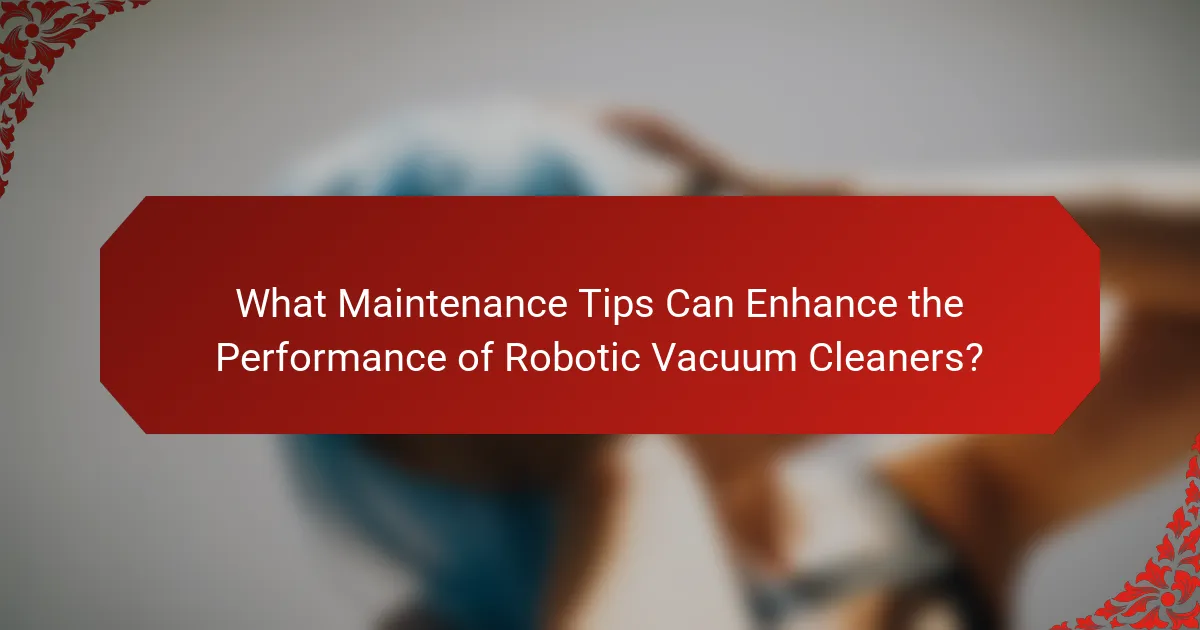
What Maintenance Tips Can Enhance the Performance of Robotic Vacuum Cleaners?
Regular maintenance enhances the performance of robotic vacuum cleaners. Cleaning the brushes and filters is essential for optimal suction. Clogged filters can reduce airflow, causing inefficiency. Emptying the dustbin frequently prevents buildup and ensures maximum capacity. Checking for tangled hair or debris on the rollers improves navigation and cleaning ability. Updating the software can enhance features and performance. Maintaining battery health by charging regularly extends operational life. Following manufacturer guidelines for maintenance can significantly improve overall efficiency.
How often should robotic vacuum cleaners be maintained?
Robotic vacuum cleaners should be maintained every 1 to 3 months. Regular maintenance ensures optimal performance and longevity. This includes cleaning the brushes, emptying the dustbin, and checking for blockages. Manufacturers often recommend specific intervals based on usage and model. Following these guidelines can prevent malfunctions. Neglecting maintenance may lead to reduced suction power and efficiency. Consistent upkeep enhances the cleaning capabilities of robotic vacuum cleaners.
What are the essential maintenance tasks to ensure optimal performance?
Regular maintenance tasks for robotic vacuum cleaners include cleaning the brushes, emptying the dustbin, and checking the filters. Cleaning the brushes prevents hair and debris buildup, which can hinder performance. Emptying the dustbin ensures optimal suction power and efficiency. Checking and replacing filters regularly maintains air quality and suction strength. Additionally, inspecting the wheels and sensors helps maintain navigation accuracy. Charging the battery fully and storing the vacuum in a cool, dry place extends its lifespan. Following these tasks can significantly improve the performance and longevity of robotic vacuum cleaners.
How can users troubleshoot common issues with robotic vacuum cleaners?
To troubleshoot common issues with robotic vacuum cleaners, users should first check for blockages in the brushes and wheels. These components can easily become tangled with hair or debris, impacting performance. Next, users should ensure that the vacuum’s sensors are clean and unobstructed. Dirty sensors can lead to navigation problems.
Additionally, users should verify that the battery is charged and functioning properly. A low or faulty battery can prevent the vacuum from operating effectively. If the vacuum is not picking up dirt, users should inspect the dustbin for clogs and empty it if necessary.
For connectivity issues, users should reset the Wi-Fi connection through the app or the vacuum’s settings. Following these steps can resolve many common problems with robotic vacuum cleaners.
What best practices should users follow for effective use?
Users should follow specific best practices for effective use of robotic vacuum cleaners. First, keep the cleaning area clear of obstacles. This ensures the vacuum can navigate freely. Second, regularly empty the dustbin to maintain suction power. A full dustbin reduces cleaning efficiency. Third, schedule cleaning times when the area is less occupied. This maximizes cleaning without interruptions. Fourth, maintain the brushes and filters by cleaning or replacing them as needed. This prolongs the lifespan of the vacuum and enhances performance. Fifth, use boundary markers to restrict access to certain areas. This prevents the vacuum from entering undesired spaces. Following these practices can significantly improve the cleaning efficiency of robotic vacuum cleaners.
How can users maximize battery life and cleaning efficiency?
Users can maximize battery life and cleaning efficiency by optimizing the settings and maintenance of their robotic vacuum cleaners. Adjusting the cleaning mode to a power-saving option can extend battery duration. Regularly cleaning filters and brushes ensures optimal performance and prevents unnecessary strain on the motor. Scheduling cleaning sessions during off-peak hours allows for uninterrupted operation. Keeping the charging dock clear of obstacles facilitates faster recharging. Additionally, using the vacuum on appropriate surfaces enhances cleaning efficiency. Research indicates that maintaining a clean vacuum can improve its suction power by up to 30%.
What tips can help in maintaining the longevity of robotic vacuum cleaners?
Regularly clean the filters and brushes of robotic vacuum cleaners. This prevents clogs and ensures optimal suction power. Check the dustbin frequently and empty it when it is half full. Keeping the dustbin clean enhances performance and longevity. Ensure the sensors are free from dust and debris. This maintains accurate navigation and cleaning efficiency. Schedule routine maintenance checks to inspect battery health and replace if necessary. A well-maintained battery can last up to 2-4 years, depending on usage. Store the vacuum in a cool, dry place when not in use. Extreme temperatures can damage internal components. Follow the manufacturer’s guidelines for software updates. This ensures the vacuum operates with the latest improvements and fixes.
Robotic vacuum cleaners are automated devices designed for efficient floor cleaning through advanced navigation and obstacle detection. This article explores the key features that enhance their performance, including suction power, brush types, and battery life, while also examining essential performance metrics such as cleaning coverage and dirt detection capabilities. Additionally, it provides practical maintenance tips to optimize cleaning efficiency and prolong the lifespan of robotic vacuums. Understanding these aspects will help users maximize the effectiveness of their robotic vacuum cleaners in maintaining clean living spaces.
